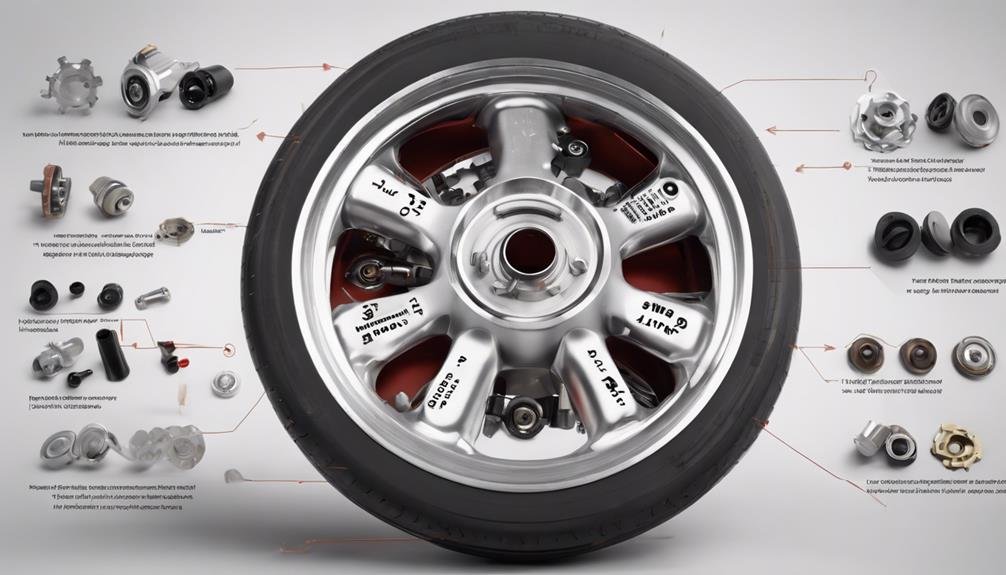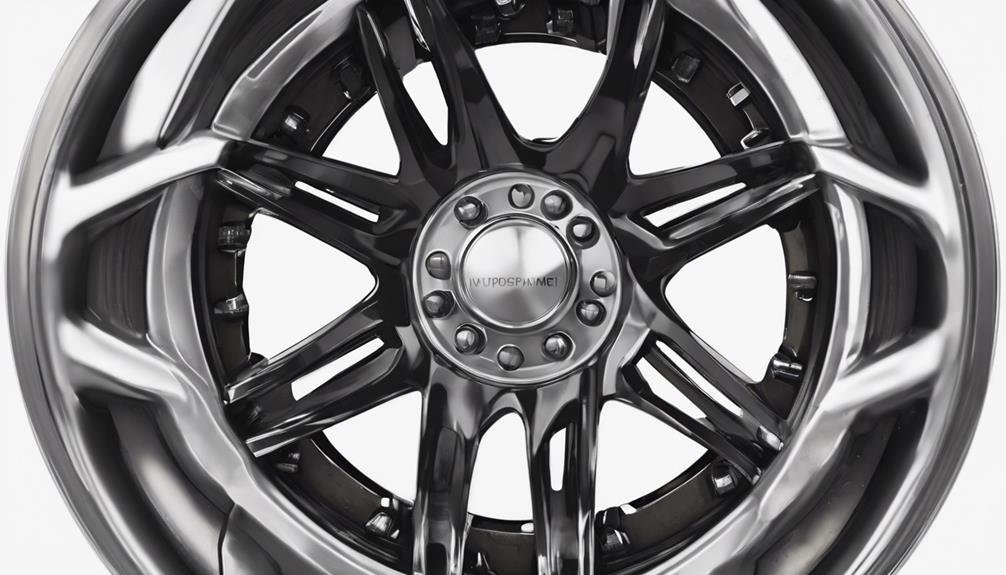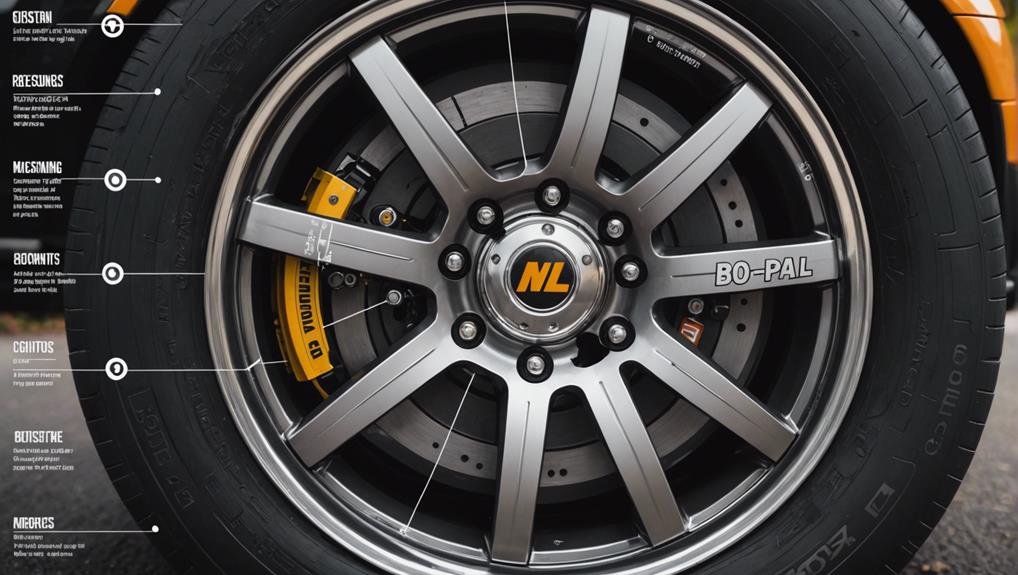When you look at your car's wheels, you're seeing a vital system of components working together to guarantee proper fitment, handling, and safety, with each wheel consisting of a hub, spokes, rim, flanges, and mounting humps. Understanding these components is essential for selecting the right wheels, ensuring proper alignment, and maintaining performance. From rim size and offset to bolt patterns and center bore, every detail matters. As you investigate your car's wheels, you'll uncover how each element contributes to a smooth ride, responsive handling, and peak performance – and learn more about what makes your car's wheels tick.
Key Takeaways
- A wheel consists of rim, spokes, hub, and outer lip, with factors like size, offset, and bolt patterns affecting proper fitment.
- Understanding wheel anatomy, including hub, spokes, rim, flanges, and mounting humps, aids in maintenance and customization.
- Wheel size and fitment are crucial for alignment, handling, performance, safety, and efficiency, involving diameter, width, and offset considerations.
- Offset determines wheel positioning and affects the overall look, with positive offset moving the wheel inward and negative offset pushing it outward.
- Accurate measurements and correct rim selection ensure proper alignment, with wheel sizing factors including diameter, width, PCD, and offset.
Understanding Wheel Diagram Basics
When you take a closer look at a wheel diagram, you'll typically find that it breaks down into several key components, including the rim, spokes, hub, and outer lip. These components work together to guarantee proper fitment and functionality of your vehicle's wheels.
Understanding wheel diagram basics is essential in selecting the right wheels for your vehicle. You'll need to take into account factors such as size, offset, and bolt patterns to make sure a proper fit. The diameter of your wheel, along with the number of bolts and their pattern, will determine the correct tire size and wheel hub.
Moreover, the center bore of the wheel must match the hub of your vehicle. Offset, which refers to the distance between the centerline of the wheel and the mounting surface, also plays a vital role in wheel positioning and fitment.
Breaking Down Wheel Anatomy
You'll find that a wheel's anatomy consists of several critical components, including the hub, spokes, rim, flanges, and mounting humps, all collaborating to guarantee proper function and safety. These components work together seamlessly to make sure your vehicle operates smoothly and efficiently.
The hub, located at the center of the wheel, provides a sturdy foundation, while the spokes radiate outward, offering structural support. The rim, the outermost part of the wheel, houses the tire, which is securely fastened by the flanges. Moreover, the mounting humps prevent the tire from slipping on the wheel during use.
The wheel plate, situated at the hub, serves as the contact point for the axle seat. Understanding wheel anatomy is essential for proper maintenance and customization. By recognizing the intricate relationships between these components, you'll be better equipped to identify potential issues and make informed decisions about upgrades or repairs.
With a solid grasp of wheel anatomy, you'll be well on your way to becoming a knowledgeable car owner.
Identifying Wheel Components

Now that you have a solid understanding of wheel anatomy, let's break down each component, starting with the spokes that connect the outer ring to the wheel plate. These spokes are an important part of the wheel's structure, providing a sturdy connection between the outer ring and the wheel plate.
Behind the spokes, you'll find the dish, a recessed area that helps to balance the wheel's design. Flanges, located on the outer ring, play a significant role in keeping the tire securely in place, ensuring a snug fit. Furthermore, mounting humps on the wheel plate prevent the tire from slipping, providing extra security.
The wheel plate itself is the point of contact between the axle seat and the wheel, connecting the two securely. When you look at the wheel as a whole, you can see how each component works together to provide a strong, stable foundation for your vehicle. By understanding these individual wheel components, you'll gain a deeper appreciation for the intricate design of your car's wheels.
Wheel Size and Fitment Explained
Your car's wheel size and fitment play an essential role in ensuring proper alignment with the wheel well, impacting everything from handling and performance to safety and fuel efficiency.
Wheel size matters, as it involves diameter, width, and offset, all critical for correct alignment.
Fitment considerations are just as significant, involving hub size, wheel center bore measurement, and the number of wheel studs for correct rim selection.
When choosing rims, consider the offset, which determines the inward or outward position of the rims, affecting the overall look and fitment of the wheels.
To guarantee proper fitment, understand your wheel specifications, including bolt patterns, and consult experts like Les Schwab if needed.
Remember, proper alignment relies on accurate measurements and correct rim selection.
Decoding Wheel Offset and Width

When it concerns customizing your ride, getting the wheel offset and width just right can make all the difference in achieving that perfect stance and peak performance. You see, the wheel offset determines how far the wheel's mounting surface is from the centerline of the wheel. A positive offset moves the wheel inward towards the car, while a negative offset pushes the wheel outward.
| Offset Type | Description |
|---|---|
| Positive Offset | Moves the wheel inward towards the car |
| Negative Offset | Pushes the wheel outward from the car |
| Zero Offset | Mounting surface aligned with the centerline |
| High Offset | Increases the distance between the mounting surface and centerline |
| Low Offset | Decreases the distance between the mounting surface and centerline |
On the other hand, wheel width is the distance between the inner and outer edges of the wheel, significantly affecting tire fitment and handling. Proper offset and width measurements are essential for achieving the desired look and top performance of your vehicle. Understanding offset and width helps in selecting wheels that fit your car's specifications and maintain proper alignment, ensuring a smooth ride and peak performance.
The Role of Hub and Lug Nuts
As you delve into customizing your ride, the often overlooked hub and lug nuts play an important role in guaranteeing your wheels are securely attached to your vehicle.
The hub, located at the center of the wheel, houses important components like brake pads and rotors. Lug nuts, on the other hand, secure the wheel onto the wheel studs mounted on the vehicle's hub.
Properly tightened lug nuts are necessary for safe driving, as loose or over-tightened lug nuts can lead to wheel detachment, compromising your safety on the road.
When installing new wheels, it's vital to ensure the center bore of the wheel matches the hub's center bore to maintain a secure connection. In addition, tightening lug nuts in a star pattern prevents wheel damage and ensures even tightening.
By understanding the critical role of hub and lug nuts, you can ensure safe operation and prevent wheel detachment, giving you peace of mind on the road.
Wheel Spacers and Hub-Centric Fit

To achieve the perfect stance or clear brake calipers, you may find yourself considering wheel spacers, which push the wheel away from the hub to create clearance or achieve a specific look.
However, it's important to understand the significance of hub-centric fit when using wheel spacers. Hub-centric spacers guarantee the wheel is centered on the hub, reducing the risk of vibrations or misalignment, which can compromise wheel balance and stability. Proper selection of spacers with a hub-centric design is necessary for maintaining wheel balance and stability.
Additionally, using spacers with the correct length bolts is crucial to avoid safety compromises. If you don't, you may experience wheel issues that can affect your driving experience. Quality hub-centric spacers are vital for safe and stable wheel fitment, enhancing the overall driving experience.
Reading and Understanding Wheel Specs
You need to decipher the cryptic codes on your wheels to guarantee a perfect fit, and it all starts with understanding the specs etched on the back of the wheel. These specifications are essential for ensuring proper fitment, and neglecting to understand them can lead to costly mistakes.
To begin, you'll want to examine the etched information on the back of the wheel, which provides key details about the wheel's size, diameter, width, and offset.
Here are the key specs to focus on:
- Diameter: The wheel's diameter, measured in inches, affects the size of the wheel and its compatibility with your vehicle.
- Width: The width of the wheel, also measured in inches, impacts the wheel's size and its ability to fit on your vehicle.
- Offset: Represented by the ET number (Einpresstiefe in German), the offset determines how the wheel sits in relation to the hub, affecting its fitment and performance.
- Configuration: The wheel's configuration, including its bolt pattern and hub bore, must match your vehicle's specifications for a proper fit.
Common Wheel Terminology Defined

What's the purpose of each component in your wheel's design, and how do they work together to guarantee a smooth ride?
Understanding common wheel terminology is vital to appreciating the intricacies of your car's wheels. Let's break down the key components: spokes, dish, flanges, mounting humps, and wheel plate.
Spokes connect the outer ring to the wheel plate, providing structural support to maintain the wheel's shape. Behind the spokes lies the dish, adding depth to the wheel design. Flanges on the wheel help keep the tire securely in place, while mounting humps prevent the tire from slipping on the wheel. The wheel plate, where the axle seat contacts the wheel, ensures proper alignment.
These components work in harmony to ensure a smooth ride, and understanding their roles is important to appreciating the complexity of your car's wheels. By grasping these fundamental concepts, you'll be better equipped to diagnose issues and maintain your vehicle's wheels with confidence.
Frequently Asked Questions
How Do You Read Wheel Information?
You'll find wheel size info on the tire sidewall or inside the driver's door frame; it includes diameter, width, and offset, which you can measure or have a pro do it for proper wheel fitment.
How to Read Wheel Measurements?
You read wheel measurements by identifying the diameter, width, and offset, ensuring the correct fitment and alignment for your vehicle; understanding these specs helps you choose the right rims for your car's unique needs.
What Do the Specs on Rims Mean?
You're wondering what the specs on rims mean? Well, they include diameter, width, and offset, which are essential for proper fitment; understanding these specs helps you choose the right wheels for your ride.
What Do 17 Inch Wheels Mean?
When you see "17 inch wheels," it means the diameter of the wheel from one end to the other is 17 inches – a common size offering a balance between performance and comfort, affecting your car's look and handling.
Conclusion
Now that you've grasped the basics of wheel diagrams, you're well-equipped to navigate the complex world of wheel anatomy, size, and fitment.
You can decode wheel specs, understand offset and width, and recognize the role of hub and lug nuts.
With this newfound knowledge, you'll be able to make informed decisions when selecting wheels for your vehicle, ensuring a perfect fit and excellent performance.
